Legal & General Group Bundle
How Well Do You Know the History of Legal & General?
Legal & General Group, a financial services giant, boasts a remarkable history that began almost two centuries ago. From its inception in a London coffee house, the company has evolved into a global powerhouse. Curious to uncover the story behind this enduring institution? Dive into the Legal & General Group SWOT Analysis to get a quick overview!
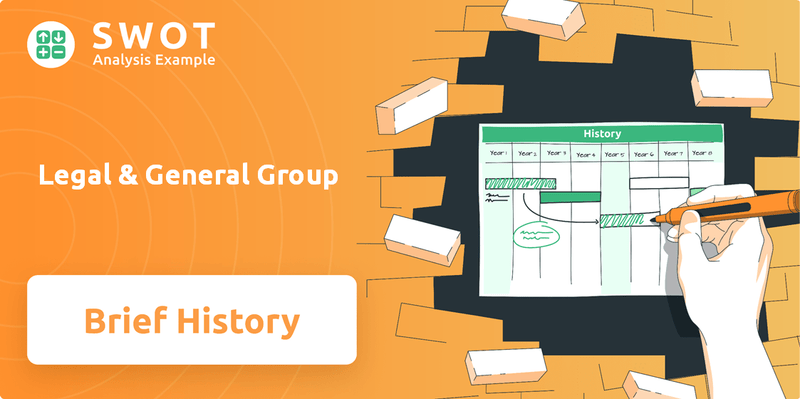
This journey through the brief history of Legal & General Group will explore its origins as an insurance company and its transformation into a leading provider of financial services. Discover the key events and milestones that shaped L&G Group, from its early years to its current status as a major player in the UK and global economy. Learn about the company timeline, its historical performance, and its impact, revealing how Legal & General has adapted and thrived.
What is the Legal & General Group Founding Story?
The story of Legal & General, or L&G Group, began in June 1836. It was a time when financial services were starting to take shape. This marked the beginning of what would become a major player in the financial world.
The founders, a group of six lawyers, met in a London coffee shop on Chancery Lane. Their vision was to address the growing need for life insurance. This led to the creation of the Legal & General Life Assurance Society.
The very first life insurance policy was issued to Thomas Smith in 1836. This early step set the stage for the company's future growth and its role in the financial landscape. Let's dive into the Legal & General history.
The establishment of Legal & General was a direct response to the needs of the time. The founders, all lawyers, brought a deep understanding of risk and legal frameworks. This was crucial for the assurance society.
- The company's name, 'Legal & General,' reflected its founders' legal expertise.
- It also signaled their intention to serve a wide 'general' public.
- The initial business model relied on premiums from policyholders to cover claims.
- This approach was typical of assurance societies at the time.
The 1830s saw the rise of financial institutions and the expansion of their services. The founders of Legal & General were well-positioned to capitalize on this trend. Their legal backgrounds gave them a significant advantage.
- The establishment of Legal & General coincided with the growth of the financial sector.
- The founders' legal backgrounds provided a strong foundation for understanding risk.
- The company's early focus was on life assurance.
- This reflected the needs of the time for financial security.
The initial policy issued to Thomas Smith was a critical early milestone. It set the stage for the company's future growth. The company's evolution reflects its commitment to serving its customers.
- The first policy issued in 1836 was a key moment for the insurance company.
- The company's early focus was on life assurance.
- Legal & General expanded its services over time.
- The company's growth reflects its adaptation to market changes.
Legal & General Group SWOT Analysis
- Complete SWOT Breakdown
- Fully Customizable
- Editable in Excel & Word
- Professional Formatting
- Investor-Ready Format
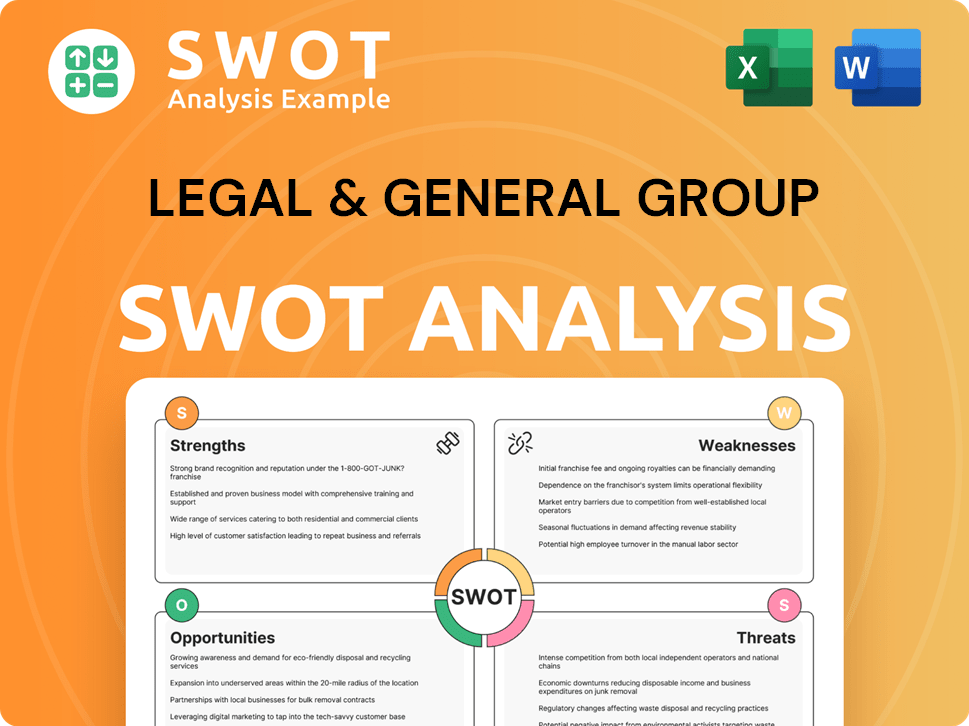
What Drove the Early Growth of Legal & General Group?
The early growth of Legal & General involved strategic expansion of its offerings and geographical reach. The company's diversification beyond insurance, including real estate ventures in the 1850s, marked an early strategic shift. By the late 1880s, Legal & General had established a significant presence in the UK, setting the stage for further developments. This period laid the foundation for the L&G Group's future growth and its position in the financial services sector.
In the 1850s, Legal & General expanded into real estate, investing in property development in areas like Birkenhead and the Belvedere Estate. This move was a significant diversification strategy beyond its core insurance business. This early venture into property helped strengthen its financial base and provided a new avenue for growth. This diversification is a key part of the Legal & General history.
By 1889, Legal & General opened its first office outside London, in Manchester, to support its growing life insurance business. This expansion marked the beginning of a broader geographical footprint. By the turn of the 20th century, the company's total assets exceeded £2 million, solidifying its position as a leading insurance company in Great Britain.
The 20th century saw Legal & General expand internationally, opening a life insurance office in Johannesburg in 1931. In 1933, it strengthened its pensions operations by acquiring the London office of Metropolitan Life Insurance. The acquisition of Gresham Life Assurance and Gresham Fire and Accident in 1934 further bolstered its market position. For a deeper understanding of the competitive landscape, consider exploring the Competitors Landscape of Legal & General Group.
The 1980s were marked by significant international expansion, including the formation of Legal & General America in 1981. The acquisition of Government Employees Life Insurance Company (GELICO), later Banner Life Insurance Company, in 1983, was a strategic move. In 1989, Legal & General America expanded further by purchasing William Penn Life Insurance Company of New York. These acquisitions played a crucial role in shaping the Legal & General Group's milestones.
Legal & General Group PESTLE Analysis
- Covers All 6 PESTLE Categories
- No Research Needed – Save Hours of Work
- Built by Experts, Trusted by Consultants
- Instant Download, Ready to Use
- 100% Editable, Fully Customizable
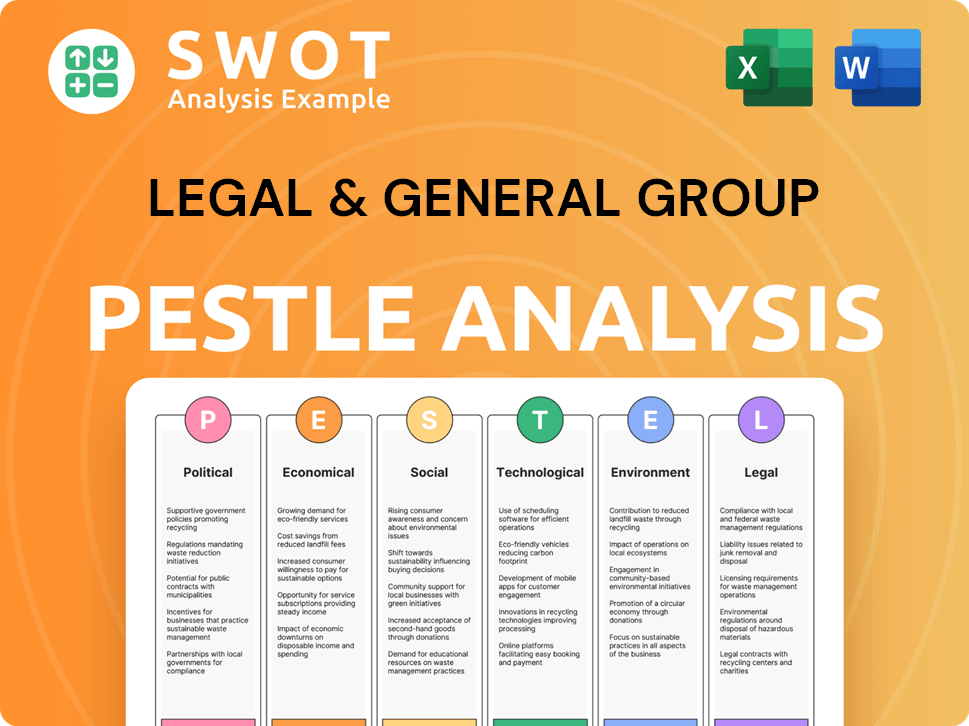
What are the key Milestones in Legal & General Group history?
The Legal & General history is marked by significant milestones that have shaped its evolution into a leading financial services provider. These key events highlight the company's growth and adaptation over time, reflecting its strategic focus and market responsiveness.
| Year | Milestone |
|---|---|
| 1932 | Introduced new pension plans for local authorities, marking an early entry into the pensions market. |
| 1988 | Became one of the first companies to offer personal pension plans, catering to evolving individual retirement needs. |
| 1996 | Formed Legal & General Investment Management (LGIM), which grew to become a major global asset management firm. |
| 2020 | Sold its general insurance business to Allianz, streamlining its operations. |
| 2024 | Merged LGIM and Legal & General Capital (LGC) into a single global unit to streamline operations and focus on high-margin businesses. |
Innovations have been central to the
In 1932, the company introduced innovative pension plans for local authorities, a move that positioned it as an early leader in the pensions market. This initiative set a precedent for future innovations in retirement solutions.
In 1988, the company was among the first to offer personal pension plans, responding to the growing need for flexible retirement solutions. This innovation provided individuals with greater control over their retirement savings.
The creation of Legal & General Investment Management (LGIM) in 1996 was a pivotal innovation, establishing a strong asset management arm. LGIM's growth has significantly contributed to the company's global presence.
LGIM has been recognized for its commitment to responsible investment, being rated top for responsible investment among the world's 15 largest asset managers by ShareAction in 2020. This focus underscores the company's commitment to sustainable practices.
In 2024, the company merged LGIM and Legal & General Capital (LGC) into a single global unit, streamlining operations. This restructuring aims to achieve operating profit targets of £500-600 million by 2028.
The strategic shift in 2024 included a focus on high-margin businesses like private credit, real estate, and pension risk transfer (PRT). This focus is designed to scale private markets AUM to £85 billion.
The
The U.S. stock market crash in 1987 led to a decrease in assets managed by its investment arm. This event highlighted the need for robust risk management strategies.
In May 2023, the company halted production at its modular homes operation, L&G Modular Homes, due to planning delays and the COVID-19 pandemic. This decision reflected challenges in scaling up new ventures.
The sale of its general insurance business to Allianz, effective January 2020, marked a strategic shift. This move allowed the company to focus on its core strengths.
In 2024, the company undertook significant strategic shifts, including the sale of Cala Group (Holdings) Limited (Cala) and its US protection business, alongside a strategic partnership with Meiji Yasuda. These moves aimed to sharpen focus and simplify the portfolio.
The merger of LGIM and LGC, along with broader market volatility, presents ongoing challenges. The company aims to navigate these challenges by focusing on high-margin businesses and strategic partnerships.
The company continuously adapts to economic and regulatory changes, which impact its operations. The focus on private markets and strategic partnerships is designed to mitigate these risks.
Legal & General Group Business Model Canvas
- Complete 9-Block Business Model Canvas
- Effortlessly Communicate Your Business Strategy
- Investor-Ready BMC Format
- 100% Editable and Customizable
- Clear and Structured Layout
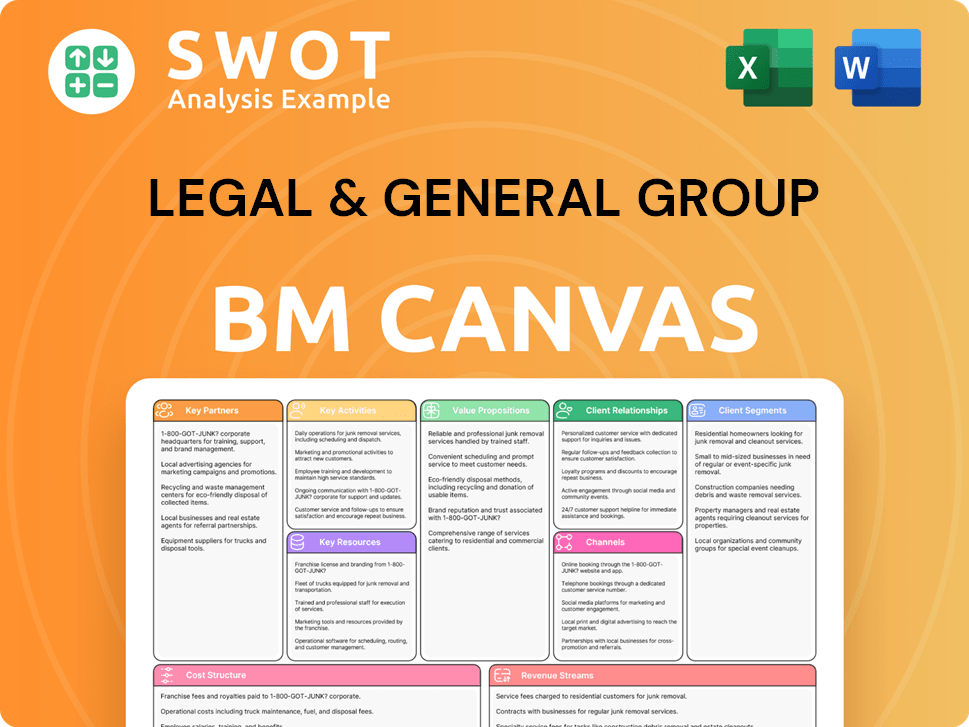
What is the Timeline of Key Events for Legal & General Group?
The Legal & General Group, a prominent financial services and insurance company, has a rich history marked by strategic expansions and adaptations to market changes. From its inception as an insurance company to its current status as a diversified financial institution, the company's journey reflects the evolution of the financial services sector. The following table outlines key milestones in the Legal & General history.
| Year | Key Event |
|---|---|
| 1836 | Founded in London as Legal & General Life Assurance Society by six lawyers. |
| 1932 | Entered the pensions market with a new pension plan for local authorities. |
| 1981 | Formed Legal & General America and acquired Government Employees Life Insurance Company (GELICO). |
| 1983 | GELICO changed its name to Banner Life Insurance Company. |
| 1988 | Introduced personal pension plans. |
| 1989 | Banner Life Insurance Company acquired William Penn Life Insurance Company of New York. |
| 1996 | Legal & General Investment Management (LGIM) was formed. |
| 2011 | Banner Life and William Penn rebranded under Legal & General America. |
| 2013 | Legal & General took a 46.5% stake in housebuilder Cala Homes, taking full control five years later. |
| 2015 | Launched L&G Modular Homes and entered the US PRT market, completing its first transaction with Royal Philips. |
| 2020 | Sold its general insurance business to Allianz. |
| 2023 | Assumed full liability for the entire pension scheme of Boots through a buy-in arrangement. |
| 2024 | Announced a refreshed strategy, merging LGIM and LGC into a single Asset Management division, and initiated a £200 million share buyback. Sold Cala Homes and its US Protection business. |
Legal & General aims to grow its Institutional Retirement business significantly. The target is to achieve £50-65 billion in UK Pension Risk Transfer (PRT) by the end of 2028. This growth strategy focuses on securing and managing pension schemes for corporate clients.
In Asset Management, Legal & General plans to achieve cumulative Annualized Net New Revenues of £100-150 million between 2025 and 2028. The company also aims to grow its Private Markets platform assets under management to £85 billion by FY 2028.
The Retail business is focused on strengthening its propositions. The target is to achieve £40-50 billion of cumulative net flows in Workplace DC between 2024 and 2028. This involves enhancing the offerings and services to attract and retain customers.
Legal & General plans to return over £5 billion to shareholders over the next three years (2025-2027) through dividends and buybacks. The company is also exploring international opportunities, particularly in the US, Canada, and the Netherlands.
Legal & General Group Porter's Five Forces Analysis
- Covers All 5 Competitive Forces in Detail
- Structured for Consultants, Students, and Founders
- 100% Editable in Microsoft Word & Excel
- Instant Digital Download – Use Immediately
- Compatible with Mac & PC – Fully Unlocked
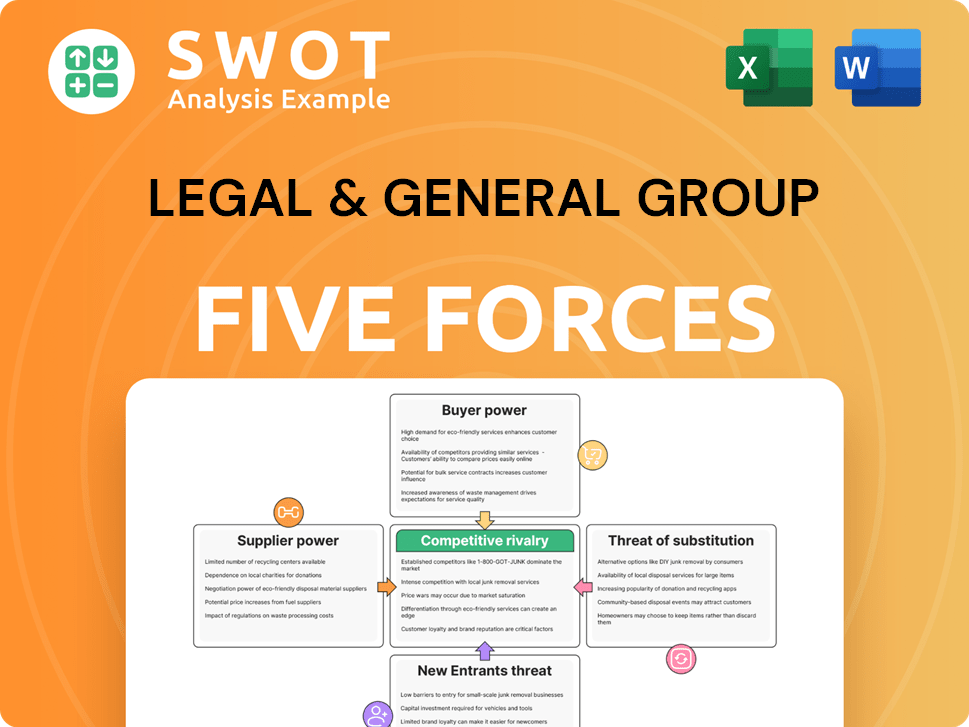
Related Blogs
- What is Competitive Landscape of Legal & General Group Company?
- What is Growth Strategy and Future Prospects of Legal & General Group Company?
- How Does Legal & General Group Company Work?
- What is Sales and Marketing Strategy of Legal & General Group Company?
- What is Brief History of Legal & General Group Company?
- Who Owns Legal & General Group Company?
- What is Customer Demographics and Target Market of Legal & General Group Company?
Disclaimer
All information, articles, and product details provided on this website are for general informational and educational purposes only. We do not claim any ownership over, nor do we intend to infringe upon, any trademarks, copyrights, logos, brand names, or other intellectual property mentioned or depicted on this site. Such intellectual property remains the property of its respective owners, and any references here are made solely for identification or informational purposes, without implying any affiliation, endorsement, or partnership.
We make no representations or warranties, express or implied, regarding the accuracy, completeness, or suitability of any content or products presented. Nothing on this website should be construed as legal, tax, investment, financial, medical, or other professional advice. In addition, no part of this site—including articles or product references—constitutes a solicitation, recommendation, endorsement, advertisement, or offer to buy or sell any securities, franchises, or other financial instruments, particularly in jurisdictions where such activity would be unlawful.
All content is of a general nature and may not address the specific circumstances of any individual or entity. It is not a substitute for professional advice or services. Any actions you take based on the information provided here are strictly at your own risk. You accept full responsibility for any decisions or outcomes arising from your use of this website and agree to release us from any liability in connection with your use of, or reliance upon, the content or products found herein.